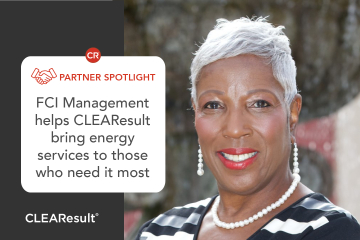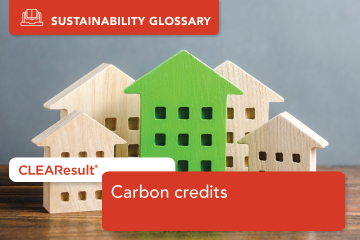<p>Last month, several members of the CLEAResult team attended the <a href="https://building-performance.org/events/national/">National Home Performance Conference</a> (NHPC) in New Orleans. This annual event, hosted by the <a href="https://building-performance.org/">Building Performance Association (BPA)</a>, brings together thousands of contractors, program administrators, auditors and other residential energy efficiency professionals to discuss the latest trends and best practices in the energy industry. </p><p><br>Here are some of the key insights and topics that stood out to our team during the conference. </p><p> </p><h3>Adapting to policy and funding uncertainty</h3><p>The conference showcased a mix of optimism and uncertainty due to shifting federal policies and the notable absence of key federal stakeholders, like the Department of Energy and Housing and Urban Development, who typically attend. Nevertheless, being at the 2025 NHPC felt like a gathering of kindred spirits. Residential energy professionals came from all over the country, united in their commitment to shaping the future of energy efficiency and exploring how our industry can continue delivering meaningful benefits to customers. This included promoting collaboration and community-driven solutions while stressing the need for creative approaches to program funding to ensure impact continuity.</p><p><br>Despite questions over the future of some federal initiatives, there was clear interest on the shape of early results from the<a href="https://www.clearesult.com/inflation-reduction-act"> Inflation Reduction Act</a> (IRA) Home Energy Rebate programs delivering energy efficiency and electrification solutions to under-resourced customers across the U.S. One session hosted by CLEAResult’s Todd Miles and Andy Gostisha focused on the early returns in Wisconsin, <a href="https://www.clearesult.com/insights/Wisconsin-Launches-First-in-the-Nat… launched its initial IRA program last August.</a> Contractors were able to preview what can be expected as other IRA state energy programs ramp up from the lessons learned here on program messaging, overcoming key challenges and more. </p><p> </p><h3>Energy efficiency is a multi-dimensional solution</h3><p>Many sessions focused on the benefits energy efficiency brings beyond energy and cost savings. A presentation led by CLEAResult’s Seth Little, Emily Kemper and Todd Miles underscored how energy efficiency can be a key to addressing grid flexibility and resilience as increased electrical demand continues to be a topic of conversation for energy providers. While program goals and funding may shift, this session urged contractors and program administrators to stay the course – energy efficiency remains the foundation of our sustainable future and the most cost-effective way of reducing impact on the grid. </p><p><br>Health and safety can be another key benefit of energy efficiency initiatives, especially with low-to-moderate income (LMI) customers who face increased health risks from unsafe or unhealthy home conditions. CLEAResult’s Rebeca Barrios-Hurst led a discussion around <a href="https://odphp.health.gov/healthypeople/priority-areas/social-determinan… determinants of health</a> and how <a href="https://www.clearesult.com/insights/prescribing-healthier-homes-webinar… Homes programs</a> can help customers with more than their electric bill. Check out a similar webinar Rebeca gave last year to learn more about the intersection of energy efficiency and health outcomes.</p><p> </p><p> </p><div class="insights-embed-container" style="display:block;" id="div-vimeo"><p><iframe src="https://www.youtube.com/embed/ISFEjGpMg30?si=uFkliNBEEw1QFsvM" width="100%" frameborder="0" webkitallowfullscreen="" mozallowfullscreen="" allowfullscreen="" data-ot-ignore=""></iframe></p><p><br>--<br>NHPC is an invaluable conference for the energy efficiency industry as program administrators, contractors and stakeholders across the country work to solve the energy challenges we face today. <a href="https://www.clearesult.com/insights/events-Q2-2025">Check out where CLEAResult staff will be speaking or attending this spring for more energy insights. </a></p><p> </p><p> </p></div>
Energy transition
Discover CLEAResult’s latest articles on energy transition and stay informed on the biggest trends for a greener and more sustainable future.

<p><span>FCI Management, led by President and CEO Patricia Watts, delivers comprehensive energy solutions that provide energy efficiency and clean energy technologies for homes and businesses across the country.</span></p><p> </p><p><span>CLEAResult first partnered with FCI Management in 2020 and together the companies have fostered a vibrant and collaborative business relationship, expanding the reach of energy efficiency programs to small businesses and income-eligible households across multiple states.</span></p><p> </p><p><span>Watts began her career at one of the nation’s most high-profile electric utility companies, gaining decades of experience working in various roles from within the call center to public affairs. She spent about ten years managing energy conservation programs with all types of customers including residential, small to medium businesses and large industrials. </span></p><p> </p><p><span>After accepting early retirement from the utility, Watts started a second career launching FCI Management. This was shortly after the energy crisis of 2001, where several factors led to Californians experiencing rolling blackouts, which were especially painful for those in the most vulnerable communities. Starting FCI allowed Watts to combine her passion for helping small businesses with her tremendous experience in energy efficiency. Some of FCI’s earliest work included small business direct programs.</span></p><p> </p><p><span>“Since the beginning, it’s been all about helping people and businesses in low-income communities reduce their energy bills,” Watts shared.</span></p><p> </p><p><span>Today, in partnership with CLEAResult, FCI leads community outreach and project management of no-cost lighting upgrades for small businesses across the state of Oregon. Program Director Brooke Landon says, “FCI’s experience helping small businesses has been invaluable in reaching this segment of customers, often in rural communities, throughout the state who have been underserved by efficiency programs in the past.” In 2024 alone, FCI supported more than 1,200 small businesses such as bookstores, churches, food banks, restaurants and vineyards, leading to over $3.4 million in savings on their energy bills.</span></p><p> </p><p><span>Since partnering with CLEAResult, Watts has continued to see significant growth, saying, “One of the reasons our programs are growing is because the entire team, FCI and CLEAResult, collaborates and works together to achieve the goal. We work well together and have adjusted over the years to continue to get more customer participation. This is a collective effort.” Watts is proud of the trust that FCI and CLEAResult are building with the community and how it has promoted the use of high-efficient heating, ventilation, air conditioning, as well as free home energy assessments and home energy score reports for small businesses and low-income households.</span></p><p> </p><p><span>Watts is committed to addressing energy inequities and serving the unique needs of under-resourced communities, which is why she serves on the board of directors for the California African American Chamber of Commerce (Chair), the California Public Utility Commission’s Low-Income Oversight Board, Advisory Board and is past chair of the CA American Association of Blacks in Energy and formerly the California Efficiency and Demand Management Council. </span></p><p> </p><p><span>Over the past two decades, FCI has helped hundreds of thousands of homes and businesses lower their energy bills and gain access to cleaner energy technologies, earning Watts a spot in the California Energy Commission’s </span><a href="https://www.energy.ca.gov/news/2024-12/cec-celebrates-winners-2024-clea… Energy Hall of Fame</span></a><span> in 2024. She also found another way to collaborate with CLEAResult when she joined the team to deliver a panel discussion at the </span><a href="https://www.clearesult.com/insights/lessons-learned-diverse-partnership… CLEAResult Energy Forum</span></a><span> and later an AESP session on Sustainable Diverse Partnerships, where she shared her expertise on the growing need for diverse partners to help utilities reach low-and-moderate income (LMI) households and hard-to-reach markets.</span></p><p> </p>

<p><img src="/sites/default/files/inline-images/alex%20abbruscato.png" data-align="left" data-entity-uuid="abdd0344-803f-43a1-84f9-2ad71b96616f" data-entity-type="file" alt="Alexandra Abbruscato" width="318">Residential batteries are a fast-emerging tool for peak load shifting. A residential battery acts like a buffer between a home and the electric grid. It can be used to mitigate local capacity constraints, to optimize daily energy usage and act as a back-up power source during an outage.</p><p> </p><p>We spoke with Senior CLEAResult Energy Transition Practice Consultant, Alexandra Abbruscato, about what she’s learned from incorporating residential batteries into demand response (DR) programs in the Northeast.</p><p> </p><h3>Why should utilities consider integrating residential battery systems into their demand response programs?</h3><p>Batteries are a reliable and predictable source of capacity. Discharging a battery doesn’t usually have a noticeable impact on customer comfort or convenience – unlike smart thermostats that control heating and cooling, or EV charging that affects a customer's vehicle use. Residential batteries are often installed for backup power or storing solar energy from a rooftop system. Utilities can take steps like setting a minimum state of charge for DR-enrolled batteries to ensure that the program has minimal effects on these other customer value streams, while providing another source of value. Batteries are also available year round and can help utilities target both summer and winter peaks.</p><p> </p><h3>What strategies have proven most effective for dispatching residential batteries in DR programs?</h3><p>Generally, one of two strategies is used for battery DR. One strategy is to dispatch batteries during discrete events on days with especially high demand to target reduction of a seasonal peak. The second strategy is to dispatch batteries at similar times each day, to target a daily peak more consistently. Batteries can also be used to optimize usage based on day-ahead pricing or time-of-use rates. While customers may use this dispatch strategy independently, utility programs can incorporate customer rate structures into program control schedules. For example, this could help to ensure that if a customer battery discharges due to an event, it does not subsequently recharge during a period of higher pricing.</p><p> </p><h3>What lessons have you learned from the initial implementations of residential battery DR programs?</h3><p>Many utilities want to start small with a battery pilot before expanding to a larger program offering, but launching a small program first can present challenges of its own. Battery original equipment manufacturers (OEMs) are more inclined to work with larger programs, as they have the potential to reach more customers. On the other hand, full program scale is difficult to achieve in many markets where the installed base of batteries remains small. Program incentives can accelerate adoption by lowering initial costs. We recommend customers ask their trusted utility provider to connect them with information about other incentives, such as state or federal tax credits, as well as local installers who are experienced with residential batteries. Utilities can also collaborate with battery OEMs and leverage OEM-driven marketing along with program marketing to boost battery uptake in the service territory. All these strategies will serve to increase the pool of eligible devices and enrolled capacity.</p><p> </p><h3>What are some key considerations utilities should keep in mind when designing a battery-based DR program?</h3><p>Utilities should look at the existing base of installed batteries in their service territory and understand which customers own batteries and why. In addition to these customer-focused benefits, batteries can provide other value streams to the grid, like participating in capacity markets or demand response programs, if they exist. It's critical for utilities to understand the full landscape of use cases and potential value streams for batteries in their service territory. Customers who have installed a battery to store on-site solar energy may use their battery differently than customers who installed a battery primarily for back-up power during outages – understanding these differences can support an effective event design. </p><p> </p><p>In some markets, OEMs or installers may offer a default option for capacity market participation, and these options must be evaluated as potentially complementary or competitive to the utility program. Successful DR programs will be able to incentivize customers for the value streams the utility is able to leverage, while dispatching the devices in a way that does not interfere with any non-DR uses of the batteries.</p><p> </p><h3>What practical steps can utilities take today to implement or enhance a residential battery DR program?</h3><p>If you have existing DR programs, particularly behavioral DR, examine whether existing batteries owners could be encouraged to participate with additional marketing and education. Then, look to support the adoption of batteries with communication and control capabilities that will enable DR program participation. Collaborating with local battery installers is a great early step for utilities who want to understand adoption trends and where they can most effectively apply influence. Of course, if the utility runs any other programs that already support batteries, reaching out to those programs early on is also an effective way to ensure that any available program incentives (for DR as well as any existing programs) are stacked for customers to help offset the initial cost of their battery. </p><p><br>While lithium-ion batteries have dominated residential energy storage, sodium-ion technology is making waves in unexpected places. For example, <a href="https://www.linkedin.com/pulse/sodium-ion-batteries-future-powering-hig… Energy is using sodium-ion batteries to power high-performance data centers</a>, helping them manage massive energy spikes without overloading the grid. If they can handle AI-driven data demands, could sodium-ion be a viable option for homes too?</p><p> </p><hr><p> </p><p><em>Alexandra Abbruscato is a Senior Energy Transition Practice Consultant focused on </em><a href="https://www.clearesult.com/practices/energy-transition"><em>distributed energy resources</em></a><em>. She has 12 years of experience in energy efficiency and energy sustainability. Before joining CLEAResult, Alexandra worked for nearly five years with Eversource, managing the energy efficiency program in Massachusetts and managing individual evaluation studies across its portfolio of energy efficiency products. She also held the co-chair on the Massachusetts Evaluation Management Committee. Alexandra holds a B.S. in Biological Engineering from Cornell and an M.B.A. from Boston University.</em></p><p> </p><p> </p>

<h2><img src="/sites/default/files/inline-images/365-forrest-ev-charging.png" data-align="right" data-entity-uuid="286d3f8b-34cd-4fbd-8ecf-ed03dcf12786" data-entity-type="file" alt="EV Charging" width="316">Background</h2><p>Our presence is steadily growing in Palo Alto, California thanks to the rapid pace of electric vehicle (EV) adoption that’s excited this community. We’ve been providing technical assistance for installing EV chargers to multi-family and mixed-use building owners since 2019 and helping residents access the EV charger rebates offered by the City of Palo Alto Utilities (CPAU).</p><p> </p><p>One notable example is the project we completed for the homeowner’s association of the apartment complex located at 365 Forest Avenue in downtown Palo Alto. Its prime location made it a unique opportunity to put Palo Alto on the map for best-in-class EV infrastructure.</p><p> </p><h2>What was the energy challenge?</h2><p>Jim M, representative of the apartment’s HOA contacted our Electric Vehicle Charging Technical Assistance Program (EVTAP) for help with accessing EV charger rebates through CPAU. As the community’s project champion, he shared their goal of installing 17 level 2 EV chargers as well as their need for a deeper understanding of the entire process. Like many of our clients, Jim and his fellow residents were unsure which EV chargers to install, or if their building could even support EV charging.</p><p> </p><h2>How did we solve the problem?</h2><p>Our Senior Practice Consultant, Peter Yeh, served as a complimentary and neutral third-party advisor, who answered questions, provided resources and helped resolve obstacles and delays. Peter began by coordinating a site visit with a CLEAResult engineer to take inventory of their existing electrical infrastructure and determine the project’s feasibility. Next, those findings were aligned with the scope of work to provide a variety of options and estimated costs. Peter presented multiple incentive programs and guided the HOA toward the program that best fit residents’ needs. He then helped the HOA find and hire a qualified installer, and submit permit applications, as well as assisting with the installation and commissioning, and ultimately, the receipt of rebates. All in all, Peter was integral to the success of this project, as echoed in Jim M.’s statement: <strong>“Peter stuck with us through an unexpectedly long project timeline – that really helped us stay with and finish the project.”</strong></p><p> </p><h2>What did we accomplish?</h2><p>We helped the HOA <strong>install 17 level 2 chargers </strong>and, in doing so, changed the landscape of downtown Palo Alto. The apartment passed their final building permit inspection and with our expertise, 365 Forest Avenue residents were able to <strong>capture $80,000 in total incentives</strong>.</p><p> </p><h2>Are there any next steps in the process?</h2><p>The apartment complex at 365 Forest Avenue was one of our first projects to complete both the CPAU EV charger rebate and the EVTAP application processes. The input from its stakeholders and the lessons learned along the way have been invaluable. We’re committed to continually raising the bar of our energy transition consulting services and offerings.</p><p> </p><p> </p>

<h2>What is a carbon credit? </h2><p>A carbon credit is a tradable permit or certificate that represents the right to emit one metric ton of carbon dioxide (CO2) or an equivalent amount of greenhouse gases (<a href="https://www.investopedia.com/terms/c/carbon_credit.asp">Source: Investopedia</a>).</p><p> </p><h2>Carbon credits vs carbon offsets</h2><p>Carbon credits are generated and purchased through cap-and-trade systems. These are government regulatory programs designed to cap total emissions and encourage reductions (<a href="https://www.investopedia.com/terms/c/cap-and-trade.asp">Source: Investopedia</a>). They are not directly linked to specific emission reduction projects. Carbon offsets, on the other hand, are directly tied to specific projects that remove or avoid greenhouse gas emissions and are purchased voluntarily by individuals or organizations to compensate for their own emissions.</p><p> </p><h2>Types of carbon credits used:</h2><ul><li><strong>Certified Emission Reductions (CERs): </strong>Generated under the Clean Development Mechanism (CDM) of the Kyoto Protocol (<a href="https://unfccc.int/process-and-meetings/the-kyoto-protocol/mechanisms-u… United Nations Climate Change</a>). <br> </li><li><strong>Emission Reduction Units (ERUs): </strong>Generated under Joint Implementation (JI) projects (<a href="https://unfccc.int/process/the-kyoto-protocol/mechanisms/joint-implemen… United Nations Climate Change</a>).<br> </li><li><strong>Voluntary Carbon Credits:</strong> Generated outside of regulated markets, often through projects that contribute to sustainable development (<a href="https://www.csis.org/analysis/voluntary-carbon-markets-review-global-in… Center for Strategic & International Studies</a>).</li></ul><h2> </h2><h2>How carbon credits work:</h2><p>1. Organizations or projects can acquire carbon credits when they implement measures to reduce or remove greenhouse gas emissions, such as by investing in renewable energy, improving energy efficiency or engaging in sustainable land use practices.</p><p> </p><p>2. The amount of emissions reduced or removed is quantified through standardized methodologies and verified by independent third-party auditors. This process ensures the accuracy and legitimacy of the claimed emission reductions.</p><p> </p><p>3. Carbon credits can be bought and sold on the carbon market. This creates a financial incentive for organizations to reduce emissions, as they can sell excess credits to those seeking to offset their emissions.</p><h2><br>History and development of carbon credits</h2><ul><li><strong>1997: Kyoto Protocol</strong></li></ul><p>The Kyoto Protocol, an international treaty, introduced market-based mechanisms to address climate change. It established the CDM and JI as flexible mechanisms for emission-reduction projects.</p><p> </p><ul><li><strong>2000: Launch of the CDM</strong></li></ul><p>The CDM officially began operations under the Kyoto Protocol, allowing countries that invest in emission-reduction projects in developing countries to receive CERs as carbon credits.</p><p> </p><ul><li><strong>2005: European Union Emissions Trading Scheme (EU ETS)</strong></li></ul><p>The EU ETS, the world's first major carbon market, was launched, and introduced cap-and-trade for carbon dioxide emissions in various sectors, with companies trading allowances based on their emissions.</p><p> </p><ul><li><strong>2008: Growth of voluntary carbon markets</strong></li></ul><p>The voluntary carbon market expanded, allowing businesses and individuals to voluntarily purchase carbon credits to offset their emissions. This market operates independently of regulatory requirements.</p><p> </p><ul><li><strong>2015: Paris Agreement</strong></li></ul><p>The Paris Agreement emphasized the role of market-based approaches in addressing climate change. While it did not establish a specific global carbon market, it recognized the importance of voluntary cooperation and the use of market mechanisms.</p><h2> </h2><h2>Why are carbon credits important?</h2><p>Carbon credits play an essential role in emissions trading and carbon markets. They provide a mechanism for businesses and governments to incentivize sustainable practices and work toward global climate goals. In essence, carbon credits foster environmentally friendly business practices and corporate responsibility. (<a href="https://climatepromise.undp.org/news-and-stories/what-are-carbon-market… United Nations Development Programme.</a>)</p><h2> </h2><h2>How CLEAResult helps organizations work with carbon credits</h2><p>We’re well-versed in creating action plans and comprehensive roadmaps that help clients surpass their sustainability goals. <a href="https://www.clearesult.com/products/CLEAResult-ATLAS-Carbon">CLEAResult ATLAS™ Carbon</a> empowers organizations by streamlining the process of calculating and tracking carbon emissions. This type of data is required to qualify for carbon credits under verification programs. We can also help with the purchase of carbon offsets for any remaining energy use.</p><p> </p><blockquote><p>“Carbon credits provide a mechanism for businesses and governments to incentivize sustainable practices and work toward global climate goals.”</p></blockquote>

<p>The electric grid is rapidly evolving, with increasing loads and a growing infrastructure. Renewable energy growth and the rise of distributed energy resources (DERs) have transformed what was once a one-way system into a dynamic network of energy exchanges. Demand is also rising due to electrification efforts, including electric vehicles (EVs) and heat pumps, as well as increased energy needs from manufacturing and data centers. As stated in recent <a href="https://www.clearesult.com/insights/our-grid-is-at-risk">CEO blog by Rich McBee,</a> electric utilities have nearly doubled their forecasts for additional power needed by 2028, after remaining relatively flat for the last 20 years. </p><p><br>With the challenge of meeting rapid growth compounded by growing shares of variable generation sources and more frequent extreme weather events, the risks to reliability and affordability are real. Real-time pricing may be the answer.</p><p><br>Real-time pricing (RTP) seeks to mitigate cost and reliability risks by passing through actual supply costs to consumers. Although the concept is not a new one, and it currently sees low rates of adoption in the U.S, we predict utilities will increasingly see the value in RTP and expand its deployment over the next five to ten years. To support this expansion in RTP, utilities should begin preparing customers for the transition now.</p><h2><br>Why real-time pricing?</h2><p>RTP brings many benefits, helping both utilities and their customers optimize energy use in ways that lower costs, reduce grid stress and promote alternative energy solutions:</p><ul style="margin-left:20px;"><li style="padding-left:10px;padding-top:1em;"><strong>Reduced grid peaks and lower costs:</strong> RTP sets higher prices for energy from costly sources, such as gas peaker plants, during high-demand times. By shifting usage to times when energy is less expensive, and to when more sustainable energy sources are available, customers can help lower system peaks and reduce generation and transmission costs.</li><li style="padding-left:10px;padding-top:1em;"><strong>Daily demand smoothing:</strong> Fluctuations in energy demand over the course of a day require adjusting generation to match this demand, and at certain times these increases and decreases can be quite dramatic. For example, the infamous “duck curve” shows a rapid ramp up in net energy demand in the late afternoon as solar generation decreases while customers turn on lights and home appliances. By encouraging load shifting, RTP can help smooth out demand curves, reducing the need for rapid increases and decreases in energy production.</li><li style="padding-left:10px;padding-top:1em;"><strong>Environmental impact: </strong>Renewable energy sources such as wind and solar have lower levelized costs of energy compared to higher-emission sources. By reflecting these lower costs at times when energy from these sources is abundant, RTP encourages customers to shift more of their consumption towards these sustainable and cost-effective energy options. </li></ul><h2><br>Considerations and challenges</h2><p>When implementing RTP, utilities, regulators and customers must be aware of the following:</p><ul style="margin-left:20px;"><li style="padding-left:10px;padding-top:1em;"><strong>Technology readiness:</strong> Real-time pricing depends on accurate tracking of supply, generation and consumption. Utilities need advanced technologies, like smart meters and robust data infrastructure, to support this. Although smart meter adoption is increasing, deploying them widely is a significant investment. Utilities can build regulator support by demonstrating RTP’s clear benefits to customers, including opportunity for future RTP and showing how technology and infrastructure investments enable RTP-driven optimization.</li><li style="padding-left:10px;padding-top:1em;"><strong>Regulatory collaboration:</strong> Regulators are tasked with protecting customers and ensuring affordability. Utilities should work with regulators to show how RTP benefits ratepayers. Offering incentives to utilities, beyond just cost recovery, can make RTP adoption more attractive by compensating for the reduced need for traditional capital investment.</li><li style="padding-left:10px;padding-top:1em;"><strong>Customer understanding and trust: </strong>Educating customers on how RTP works, how it benefits them, and how it can lower costs through optimized energy use is crucial. Clear, transparent communication will build customer trust and help prevent misunderstandings about more complex rate structures.</li><li style="padding-left:10px;padding-top:1em;"><strong>Timeline for transition: </strong>Shifting to RTP could take five to ten years, as each new rate structure needs at least a year for impact assessment. Any required technology deployment will further extend this timeline.</li><li style="padding-left:10px;padding-top:1em;"><strong>Supporting all customer segments:</strong> RTP must be designed equitably. While some customers can shift their energy use, others with rigid schedules might not have this flexibility. Targeted programs can help ensure RTP works for all customers, including low-income households and those with limited ability to shift load.</li><li style="padding-left:10px;padding-top:1em;"><strong>Cost control mechanisms:</strong> To protect customers from price volatility, utilities could implement cost caps or rate designs with regulatory oversight. These measures ensure vulnerable customers are shielded from excessive price swings while still attaining the bulk of the benefits that uncapped RTP has to offer.</li></ul><h2><br>The role of automation and smart devices</h2><p>If a world where customers are constantly watching price signals and frantically running around turning devices on and off is not your idea of energy utopia, don’t fear. That’s not how RTP will work. Effective RTP needs to be implemented by pre-configured responses programmed into the energy-using equipment. As RTP scales, automated controls and smart devices will become essential for managing complex rates. Automated systems can optimize energy use on behalf of customers, adjusting usage in response to price signals without requiring their direct input. </p><p><br>As connected devices allow third parties to better manage energy loads across households, neighborhoods or even cities, they can provide collective benefits and maximize grid flexibility. While there still exists a technology-readiness barrier for integration of smart devices onto the grid, this connectivity will be a key piece of the RTP optimization puzzle. As technology improves, opportunities for the use of smart devices will expand. </p><p><br>The California Energy Commission (CEC) is paving the way for smart devices to enable RTP with the <a href="https://www.energy.ca.gov/proceedings/market-informed-demand-automation… Informed Demand Automation Server (MIDAS).</a> MIDAS provides access to the time-varying rates of utilities and tracks greenhouse gas emission signals. Solutions like MIDAS need buy-in and investments from manufacturers to scale, which can be encouraged through utility support for emerging technology studies and pilots.</p><h2><br>The roadmap to real-time pricing</h2><p>Guiding customers along the RTP journey could take several steps, from simple flat-rate structures to more dynamic pricing: </p><table><thead><tr><th style="color:#6D6D6D;font-family:'AvenirNext Bold', sans-serif;font-size:2rem;letter-spacing:0.03px;"><strong>Type of pricing</strong></th><th style="color:#6D6D6D;font-family:'AvenirNext Bold', sans-serif;font-size:2rem;letter-spacing:0.03px;"><strong>Description</strong></th></tr></thead><tbody><tr><td style="color:#707070;font-family:'AvenirNext Medium', sans-serif;font-size:1.7rem;padding-left:20px;">Flat rate</td><td style="color:#707070;font-size:1.7rem;padding-left:20px;">A fixed price per unit of energy, regardless of the time of day.</td></tr><tr><td style="color:#707070;font-family:'AvenirNext Medium', sans-serif;font-size:1.7rem;padding-left:20px;">Peak time rebate (PTR) programs</td><td style="color:#707070;font-family:'AvenirNext Regular', sans-serif;font-size:1.7rem;letter-spacing:0.03px;padding-left:20px;">Voluntary programs that reward customers for reducing energy use during peak times. PTR programs are event-based and do not necessarily come before TOU rates.</td></tr><tr><td style="color:#707070;font-family:'AvenirNext Medium', sans-serif;font-size:1.7rem;padding-left:20px;">Time-of-use (TOU) rates</td><td style="color:#707070;font-family:'AvenirNext Regular', sans-serif;font-size:1.7rem;letter-spacing:0.03px;padding-left:20px;">Rates vary between on- and off-peak periods, with a pre-defined schedule. TOU rates are an average.</td></tr><tr><td style="color:#707070;font-family:'AvenirNext Medium', sans-serif;font-size:1.7rem;padding-left:20px;">Variable peak pricing (VPP)</td><td style="color:#707070;font-family:'AvenirNext Regular', sans-serif;font-size:1.7rem;letter-spacing:0.03px;padding-left:20px;">This is similar to TOU, but with flexible peak periods based on anticipated demand.</td></tr><tr><td style="color:#707070;font-family:'AvenirNext Medium', sans-serif;font-size:1.7rem;padding-left:20px;">Real-time pricing (RTP)</td><td style="color:#707070;font-family:'AvenirNext Regular', sans-serif;font-size:1.7rem;letter-spacing:0.03px;padding-left:20px;">Rates reflect real-time grid conditions, varying throughout the day to reflect supply and demand.</td></tr></tbody></table><p>The steps along this road are not always linear, and in some cases, customers have several of these steps available to them at the same time.</p><p><br>As customers move through these stages, automated controls and connected devices will make managing energy easier, helping to drive adoption.</p><h2><br>Key takeaways</h2><p>The path to real-time pricing offers immense potential for reducing costs, supporting clean energy, and enhancing grid stability. By taking a measured approach and prioritizing customer education, utilities can guide their customers through the transition.</p><p><br>CLEAResult is ready to support utilities at every step, helping build the trust, knowledge and tools needed for a smooth shift to RTP. </p><p><br>We can help with:</p><ul style="margin-left:20px;"><li style="padding-left:10px;padding-top:1em;"><strong>Customer segmentation and analytics: </strong>We help utilities tailor demand management programs for different customer segments, ensuring equitable and effective implementation.</li><li style="padding-left:10px;padding-top:1em;"><strong>Program design:</strong> CLEAResult has expertise in demand response and managed charging programs that lay the groundwork for RTP.</li><li style="padding-left:10px;padding-top:1em;"><strong>Customer support and outreach: </strong>Our connected device marketplace, marketing and education programs support customer engagement and understanding.</li><li style="padding-left:10px;padding-top:1em;"><strong>Measuring impacts:</strong> Gaining insight on load impacts and customer experience from pilots and early pricing programs will inform and shape the path forward. </li></ul><p> </p><p>Learn more about what our <a href="https://www.clearesult.com/practices/energy-transition">Energy Transition specialists</a> can offer on our website.</p><p> </p><hr><p> </p><p>Michael O’Brien Crayne is Senior Practice Consulting Manager in CLEAResult’s Energy Transition practice in the U.S. East and Canada regions, designing, evolving and growing the impact achieved by electrification and distributed energy resource products and services. <br> </p><p> </p><p> </p>
